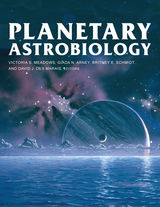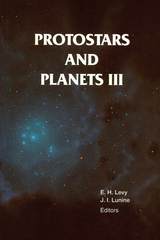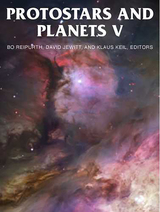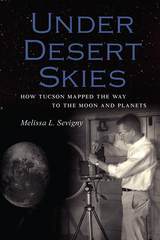6 books about Planetary science

Planetary Astrobiology
Edited by Victoria S. Meadows, Giada N. Arney, Britney E. Schmidt, and David J. Des Marais
University of Arizona Press, 2020
Are we alone in the universe? How did life arise on our planet? How do we search for life beyond Earth? These profound questions excite and intrigue broad cross sections of science and society. Answering these questions is the province of the emerging, strongly interdisciplinary field of astrobiology. Life is inextricably tied to the formation, chemistry, and evolution of its host world, and multidisciplinary studies of solar system worlds can provide key insights into processes that govern planetary habitability, informing the search for life in our solar system and beyond. Planetary Astrobiology brings together current knowledge across astronomy, biology, geology, physics, chemistry, and related fields, and considers the synergies between studies of solar systems and exoplanets to identify the path needed to advance the exploration of these profound questions.
Planetary Astrobiology represents the combined efforts of more than seventy-five international experts consolidated into twenty chapters and provides an accessible, interdisciplinary gateway for new students and seasoned researchers who wish to learn more about this expanding field. Readers are brought to the frontiers of knowledge in astrobiology via results from the exploration of our own solar system and exoplanetary systems. The overarching goal of Planetary Astrobiology is to enhance and broaden the development of an interdisciplinary approach across the astrobiology, planetary science, and exoplanet communities, enabling a new era of comparative planetology that encompasses conditions and processes for the emergence, evolution, and detection of life.
Planetary Astrobiology represents the combined efforts of more than seventy-five international experts consolidated into twenty chapters and provides an accessible, interdisciplinary gateway for new students and seasoned researchers who wish to learn more about this expanding field. Readers are brought to the frontiers of knowledge in astrobiology via results from the exploration of our own solar system and exoplanetary systems. The overarching goal of Planetary Astrobiology is to enhance and broaden the development of an interdisciplinary approach across the astrobiology, planetary science, and exoplanet communities, enabling a new era of comparative planetology that encompasses conditions and processes for the emergence, evolution, and detection of life.
[more]

Protostars and Planets III
Eugene Levy
University of Arizona Press, 1993
Previous Space Science Series volumes Protostars and Planets (1978) and Protostars and Planets II (1985) were among the most timely offerings of this illustrious collection of technical works. Protostars and Planets III continues to address fundamental questions concerning the formation of stars and planetary systems in general and of our solar system in particular. Drawing from advances in observational, experimental, and theoretical research, it summarizes our understanding of these processes and addresses major open questions and research issues. Among the more notable subjects covered in the more than three dozen chapters are the collapse of clouds and the formation and evolution of stars and disks; nucleosynthesis and star formation; the occurrence and properties of disks around young stars; T Tauri stars and their accretion disks; gaseous accretion and the formation of the giant planets; comets and the origin of the Solar-System; and the long-term dynamical evolution and stability of the solar system.
Protostars and Planets III reflects the enormous progress made in understanding star and planet formation as a result of new observational capabilities and cooperative research among scientists from diverse fields.
Protostars and Planets III reflects the enormous progress made in understanding star and planet formation as a result of new observational capabilities and cooperative research among scientists from diverse fields.
[more]

Protostars and Planets IV
Vince Mannings
University of Arizona Press, 2000
Atextbook and a status report for every facet of research into the formation of stars and planets, Protostars and Planets IV brings together 167 authors who report on the most significant advances in the field since the publication of the previous volume in 1993. Protostars and Planets IV reflects improvements in observational techniques and the availability of new facilities such as the Infrared Space Observatory, the refurbished Hubble Space Telescope, and the 10-m Keck telescopes. Advances in computer technology and modeling methods have benefited theoretical studies of molecular clouds, star formation, and jets and disks, while recent analyses of meteorites yield important insights into conditions and processes within our Sun's early protoplanetary disk. The 49 chapters describe context and progress for observational and theoretical studies of the structure, chemistry, and dynamics of molecular clouds; the collapse of cores and the formation of protostars; the formation and properties of young binary stars; the properties of winds, jets, and molecular outflows from young stellar objects; the evolution of circumstellar envelopes and disks; grain growth in disks and the formation of planets; and the properties of the early Solar nebula.
Protostars and Planets IV is also the first book to include chapters describing the discoveries of extrasolar planets, brown dwarfs, and Edgeworth-Kuiper Belt objects, and the first to include high-resolution optical and near-infrared images of protoplanetary disks. Protostars and Planets IV is an unsurpassed reference not only for established researchers but also for younger scientists whose imagination and work will lead to tomorrow's discoveries.
Protostars and Planets IV is also the first book to include chapters describing the discoveries of extrasolar planets, brown dwarfs, and Edgeworth-Kuiper Belt objects, and the first to include high-resolution optical and near-infrared images of protoplanetary disks. Protostars and Planets IV is an unsurpassed reference not only for established researchers but also for younger scientists whose imagination and work will lead to tomorrow's discoveries.
[more]

Protostars and Planets V
Edited by Bo Reipurth, David Jewitt, and Klaus Keil
University of Arizona Press, 2007
Increasing discoveries of new planets beyond our solar system are invigorating the quest for new knowledge and understanding of the birth of stars and planets. This new volume in the Space Science Series, with 249 contributing authors, builds on the latest results from recent advances in ground and space-based astronomy and in numerical computing techniques to offer the most detailed and up-to-date picture of star and planet formation, including the formation of our own solar system. This book emphasizes the cross-disciplinary aspects of the field, with a particular focus on the early evolution of our solar system. Protostars and Planets V is the new foundation for further advancement in the fields of stellar and planetary formation, making it an indispensable resource for researchers and students in astronomy, planetary science, and the study of meteorites.
[more]

The Space Age Generation
Lives and Lessons from the Golden Age of Solar System Exploration
William Sheehan and Klaus Brasch
University of Arizona Press, 2024
In 1957 Sputnik launched toward the stars. President Kennedy then announced that the United States would send men to the Moon and then return them to Earth.These pivotal moments sparked an unequaled bound forward in human innovation and scientific exploration.
At the heart of this momentous time were the men and women working behind the scenes. Scientists, historians, and astronomers share their memories and contributions from this unparalleled era in essays told in their own words. They are the remarkable generation who witnessed and contributed to some of space science’s most stunning achievements. Here they have recorded their memories—their childhood inspirations, their challenges, failures, and triumphs—for future generations.
A unique and authoritative record of a momentous period in human history, The Space Age Generation highlights the golden age of space exploration and the people who made it happen.
Contributors
Leo Aerts
Alexander Basilevsky
Klaus Brasch
Clark R. Chapman
Dale P. Cruikshank
William K. Hartmann
William Leatherbarrow
Baerbel Koesters Lucchitta
Yvonne Pendleton
Peter H. Schultz
William Sheehan
Paolo Tanga
Charles A. Wood
At the heart of this momentous time were the men and women working behind the scenes. Scientists, historians, and astronomers share their memories and contributions from this unparalleled era in essays told in their own words. They are the remarkable generation who witnessed and contributed to some of space science’s most stunning achievements. Here they have recorded their memories—their childhood inspirations, their challenges, failures, and triumphs—for future generations.
A unique and authoritative record of a momentous period in human history, The Space Age Generation highlights the golden age of space exploration and the people who made it happen.
Contributors
Leo Aerts
Alexander Basilevsky
Klaus Brasch
Clark R. Chapman
Dale P. Cruikshank
William K. Hartmann
William Leatherbarrow
Baerbel Koesters Lucchitta
Yvonne Pendleton
Peter H. Schultz
William Sheehan
Paolo Tanga
Charles A. Wood
[more]

Under Desert Skies
How Tucson Mapped the Way to the Moon and Planets
Melissa L. Sevigny
University of Arizona Press, 2016
President Kennedy’s announcement that an American would walk on the Moon before the end of the 1960s took the scientific world by surprise. The study of the Moon and planets had long fallen out of favor with astronomers: they were the stuff of science fiction, not science.
An upstart planetary laboratory in Tucson would play a vital role in the nation’s grand new venture, and in doing so, it would help create the field of planetary science. Founded by Gerard P. Kuiper in 1960, the Lunar and Planetary Laboratory (LPL) at the University of Arizona broke free from traditional astronomical techniques to embrace a wide range of disciplines necessary to the study of planets, including geology, atmospheric sciences, and the elegant emerging technology of spacecraft. Brash, optimistic young students crafted a unique sense of camaraderie in the fledgling institution. Driven by curiosity and imagination, LPL scientists lived through—and, indeed, made happen—the shattering transition in which Earth’s nearest neighbors became more than simple points of light in the sky.
Under Desert Skies tells the story of how a small corner of Arizona became Earth’s ambassador to space. From early efforts to reach the Moon to the first glimpses of Mars’s bleak horizons and Titan’s swirling atmosphere to the latest ambitious plans to touch an asteroid, LPL’s history encompasses humanity’s unfolding knowledge about our place in the universe.
An upstart planetary laboratory in Tucson would play a vital role in the nation’s grand new venture, and in doing so, it would help create the field of planetary science. Founded by Gerard P. Kuiper in 1960, the Lunar and Planetary Laboratory (LPL) at the University of Arizona broke free from traditional astronomical techniques to embrace a wide range of disciplines necessary to the study of planets, including geology, atmospheric sciences, and the elegant emerging technology of spacecraft. Brash, optimistic young students crafted a unique sense of camaraderie in the fledgling institution. Driven by curiosity and imagination, LPL scientists lived through—and, indeed, made happen—the shattering transition in which Earth’s nearest neighbors became more than simple points of light in the sky.
Under Desert Skies tells the story of how a small corner of Arizona became Earth’s ambassador to space. From early efforts to reach the Moon to the first glimpses of Mars’s bleak horizons and Titan’s swirling atmosphere to the latest ambitious plans to touch an asteroid, LPL’s history encompasses humanity’s unfolding knowledge about our place in the universe.
[more]
READERS
Browse our collection.
PUBLISHERS
See BiblioVault's publisher services.
STUDENT SERVICES
Files for college accessibility offices.
UChicago Accessibility Resources
home | accessibility | search | about | contact us
BiblioVault ® 2001 - 2024
The University of Chicago Press









